Urban Outfitters Bundle
How did Urban Outfitters go from a college store to a global brand?
Urban Outfitters, a name synonymous with trendsetting fashion, began its journey near the University of Pennsylvania. From its humble beginnings in 1970 as 'The Free People,' the company has evolved into a global lifestyle retail giant. This Urban Outfitters SWOT Analysis will help you understand the company's trajectory.
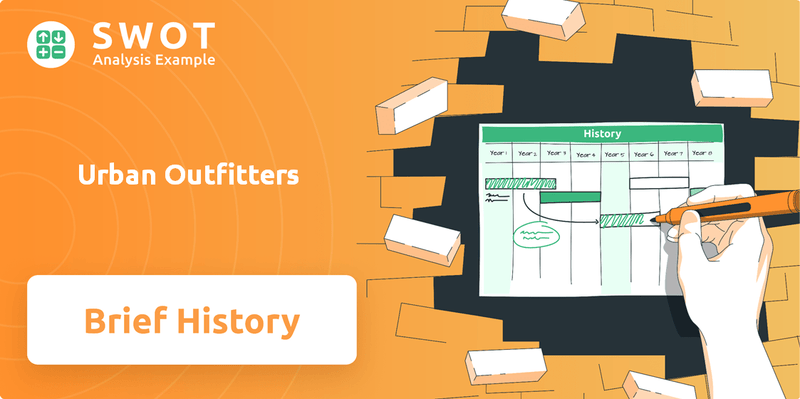
This brief history of Urban Outfitters explores its remarkable transformation. Discover how the company, with brands like Anthropologie and Free People, navigated the retail industry's evolution, impacting fashion and expanding its reach. We'll examine the key moments and strategic decisions that shaped UO's brand evolution, from its early years in Philadelphia to its current status.
What is the Urban Outfitters Founding Story?
The story of Urban Outfitters begins on February 18, 1970. Richard Hayne, Scott Belair, and Judy Wicks, all students at the University of Pennsylvania, saw an opportunity in the retail market. They aimed to offer affordable and unique products to the youth of the time.
Initially called 'The Free People,' the first store was located near the University of Pennsylvania campus in Philadelphia. The founders pooled their resources to launch the business, focusing on a mix of second-hand clothing, furniture, jewelry, and home goods. The brand's evolution is a fascinating look at the Marketing Strategy of Urban Outfitters.
The company adopted the name 'Urban Outfitters' in 1976. This change reflected the expansion of the brand beyond clothing to include lifestyle products. This shift broadened the appeal to a wider audience with an 'urban' aesthetic.
The founders' understanding of their target demographic was key to the early success of Urban Outfitters.
- The initial store offered a unique shopping experience.
- The inventory was constantly changing to maintain freshness.
- The atmosphere was informal and communal, encouraging customer interaction.
- The early business model focused on providing accessible and authentic products.
Urban Outfitters SWOT Analysis
- Complete SWOT Breakdown
- Fully Customizable
- Editable in Excel & Word
- Professional Formatting
- Investor-Ready Format
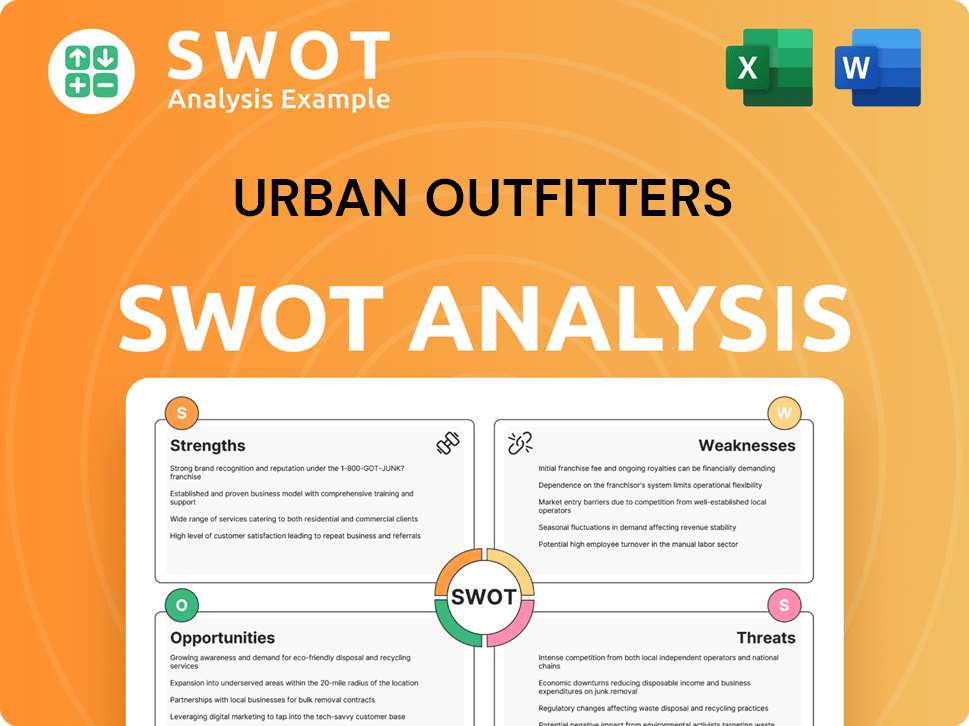
What Drove the Early Growth of Urban Outfitters?
The early growth of the company, now known as Urban Outfitters, was marked by a steady expansion following its initial success. The company leveraged its strong presence in Philadelphia to open stores in college towns across the Northeast. This strategy, combined with the introduction of new product categories, solidified its position as a lifestyle brand.
A significant moment was the 1992 launch of Anthropologie. This new brand catered to an older, more affluent demographic, offering a curated collection of apparel and home furnishings. This diversification allowed the company to tap into a new market segment while maintaining the distinct identity of its flagship brand. The success of Anthropologie demonstrated the company's ability to replicate its unique retail experience across different consumer segments.
In 1999, the company further diversified with the acquisition of Free People. Free People had originated as the 'Free People' store concept before being re-launched as a distinct bohemian-inspired women's apparel brand. The reacquisition and subsequent growth of Free People further solidified the company's multi-brand strategy.
The company went public in 1993, which provided capital for further expansion. Throughout the 1990s and early 2000s, the company continued to open new stores domestically and began exploring international markets. The rise of e-commerce also played a crucial role, with investment in online platforms to reach a wider customer base. The company established robust supply chain and distribution networks to support its growing retail footprint.
By the mid-2000s, the company had established itself as a multi-brand powerhouse, adept at identifying and catering to niche lifestyle markets. This was a testament to its strategic foresight and adaptability in a competitive retail landscape. Learn more about the company's financial performance and business model in this detailed analysis of Revenue Streams & Business Model of Urban Outfitters.
Urban Outfitters PESTLE Analysis
- Covers All 6 PESTLE Categories
- No Research Needed – Save Hours of Work
- Built by Experts, Trusted by Consultants
- Instant Download, Ready to Use
- 100% Editable, Fully Customizable
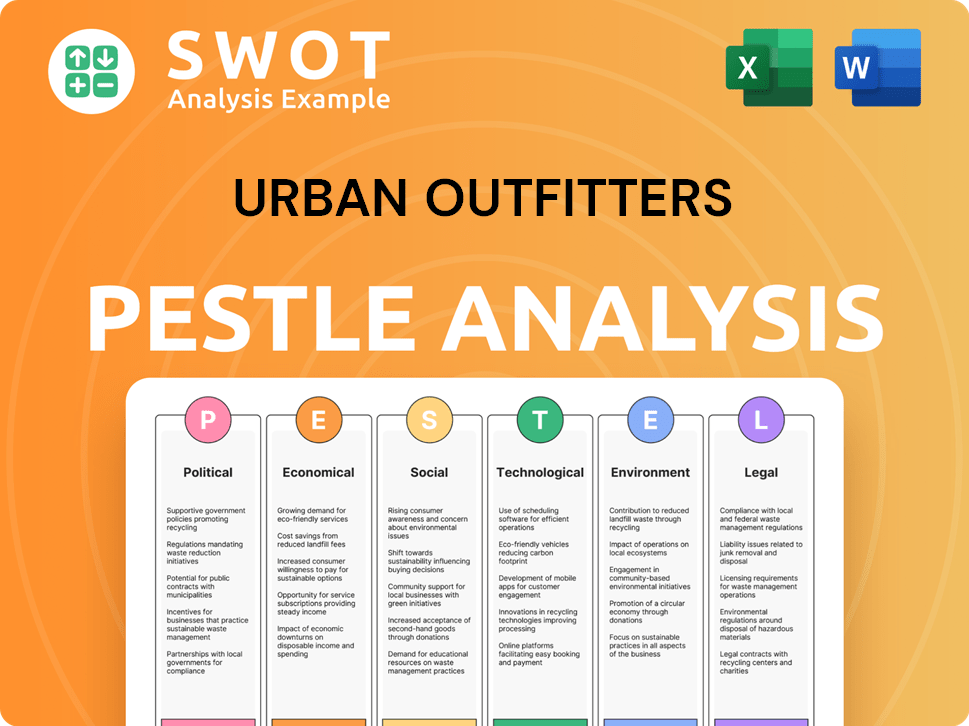
What are the key Milestones in Urban Outfitters history?
The Urban Outfitters company has experienced significant growth and change since its inception. From its humble beginnings to its current status as a multi-brand retailer, the company has consistently adapted to market trends while maintaining a distinct brand identity. This UO history is marked by strategic expansions, innovative retail concepts, and a keen understanding of its target audience.
| Year | Milestone |
|---|---|
| 1970 | The first store opened in Philadelphia, Pennsylvania, offering a curated selection of clothing and home goods. |
| 1992 | Anthropologie, a brand catering to a more mature demographic, was launched, expanding the company's market reach. |
| 1999 | Free People, a bohemian-inspired brand, was introduced, further diversifying the company's portfolio. |
| 2004 | The company went public, marking a significant step in its growth and expansion. |
| 2019 | Nuuly, a clothing rental subscription service, was launched, reflecting a shift towards the circular economy. |
Urban Outfitters history is also defined by its innovative approach to retail. The company has consistently focused on creating immersive shopping experiences, transforming stores into destinations that encourage exploration and discovery. This strategy, combined with a strong understanding of its customer base, has allowed the company to build a loyal following and maintain its relevance in the competitive retail industry history.
The company pioneered experiential retail by creating unique store layouts and curated product assortments. This approach encouraged customers to explore and engage with the brand beyond simple transactions.
The successful launch of Anthropologie and Free People demonstrated the company's ability to segment the market. These brands catered to different consumer tastes while still aligning with the company's core values.
The company expanded into new lifestyle categories, including home goods, beauty, and activewear. This diversification broadened its appeal and created new revenue streams.
The company has invested heavily in its e-commerce platforms, supply chain optimization, and digital marketing strategies. This has helped it stay competitive in the rapidly evolving digital landscape.
Nuuly, the clothing rental subscription service, represents an innovative response to changing consumer behaviors. By the end of fiscal year 2023, Nuuly had over 180,000 active subscribers.
The company uses data-driven merchandising to adapt to rapid changes in fashion cycles. This helps them optimize inventory management and respond to consumer demand effectively.
Despite its successes, the Urban Outfitters company has faced several challenges. The company has navigated economic downturns, shifting consumer preferences, and intense competition. Moreover, the company has sometimes faced criticism regarding product design and marketing campaigns, requiring strategic responses to address public concerns. Understanding the Target Market of Urban Outfitters is essential to understanding its challenges and successes.
Like many retailers, the company has been affected by economic downturns, which impact consumer spending and demand. These periods require strategic adjustments to maintain profitability.
Changing consumer tastes and preferences require the company to constantly adapt its product offerings and marketing strategies. This includes staying on top of fashion trends and consumer values.
The company faces intense competition from fast-fashion retailers and e-commerce giants. This requires continuous innovation and differentiation to maintain market share.
Challenges related to inventory management and adapting to rapid changes in fashion cycles have been persistent. The company has responded through supply chain improvements and data-driven merchandising.
The rapid evolution of digital retail has necessitated continuous investment in e-commerce platforms. The company has focused on initiatives like Nuuly, its rental subscription service launched in 2019.
The company has sometimes faced criticism for product designs or marketing campaigns. This requires strategic responses to address these concerns and maintain brand reputation.
Urban Outfitters Business Model Canvas
- Complete 9-Block Business Model Canvas
- Effortlessly Communicate Your Business Strategy
- Investor-Ready BMC Format
- 100% Editable and Customizable
- Clear and Structured Layout
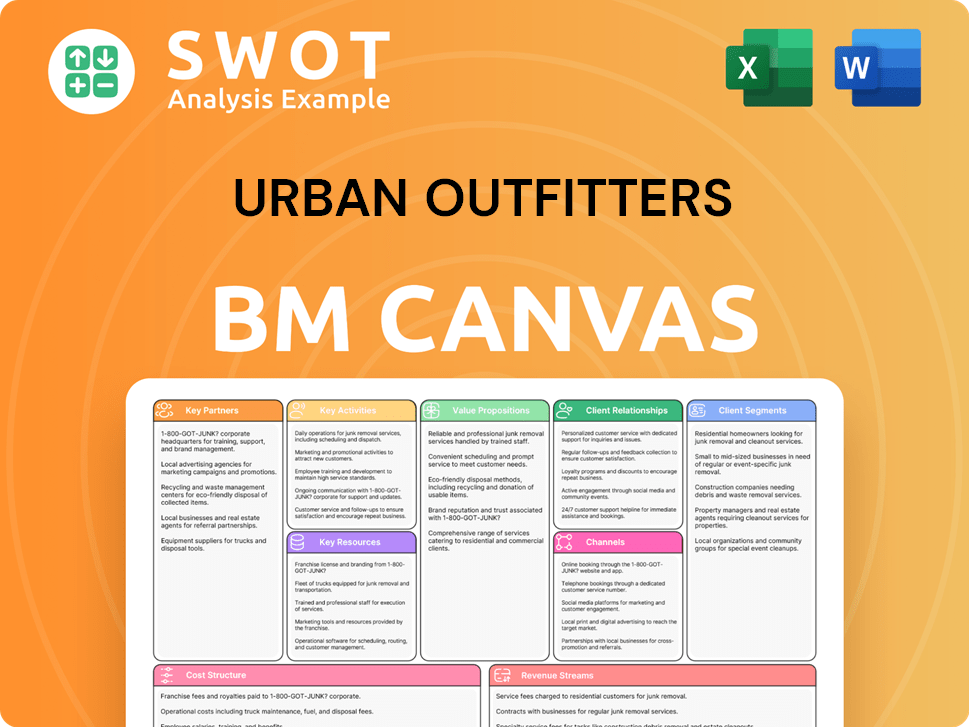
What is the Timeline of Key Events for Urban Outfitters?
The story of the Urban Outfitters company is a journey through retail innovation, beginning in 1970 near the University of Pennsylvania. Initially named 'The Free People,' the store evolved into the brand we know today, expanding its reach through new concepts and adapting to changing consumer trends. The company's evolution showcases its ability to identify and cater to niche markets, from its early days to its current focus on digital transformation and the circular economy.
| Year | Key Event |
|---|---|
| 1970 | Richard Hayne, Scott Belair, and Judy Wicks opened 'The Free People' store. |
| 1976 | The store was renamed Urban Outfitters, Inc. |
| 1992 | The brand Anthropologie was launched. |
| 1993 | Urban Outfitters, Inc. went public on the NASDAQ stock exchange. |
| 1999 | Free People was re-launched as a distinct women's apparel brand. |
| 2008 | Terrain, a garden and home brand, was launched. |
| 2012 | The company expanded internationally, opening stores in Europe. |
| 2019 | Nuuly, a clothing rental subscription service, was launched. |
| 2020-2021 | The company navigated the challenges of the COVID-19 pandemic, accelerating digital transformation. |
| 2023 | Nuuly reported significant growth, reaching over 180,000 active subscribers. |
| 2024 | The company continues to focus on digital acceleration, inventory management, and strategic expansion of its core brands and Nuuly. |
Nuuly's success is a key indicator of the company's ability to adapt to the circular economy. In 2023, Nuuly had over 180,000 subscribers, showcasing significant growth. The continued expansion of Nuuly is a primary focus, aiming for increased subscriber numbers and profitability. This growth reflects the rising consumer interest in rental services.
Digital platforms are central to the company's strategy. Investments in digital platforms across all brands are ongoing, enhancing the online shopping experience. The company aims to integrate e-commerce with its physical retail footprint. This includes improved user interfaces and personalized shopping experiences.
Efficient inventory management and supply chain optimization are critical. The company is refining its inventory management to improve efficiency and respond to fashion trends. Agile inventory management is crucial for staying competitive. This involves real-time data analysis and quick decision-making.
The company's long-term outlook depends on adapting to evolving consumer preferences, especially among younger demographics. This involves offering unique lifestyle products and experiences. The company aims to stay true to its founding vision of providing distinctive offerings for its target audience. Brand evolution is a constant process.
Urban Outfitters Porter's Five Forces Analysis
- Covers All 5 Competitive Forces in Detail
- Structured for Consultants, Students, and Founders
- 100% Editable in Microsoft Word & Excel
- Instant Digital Download – Use Immediately
- Compatible with Mac & PC – Fully Unlocked
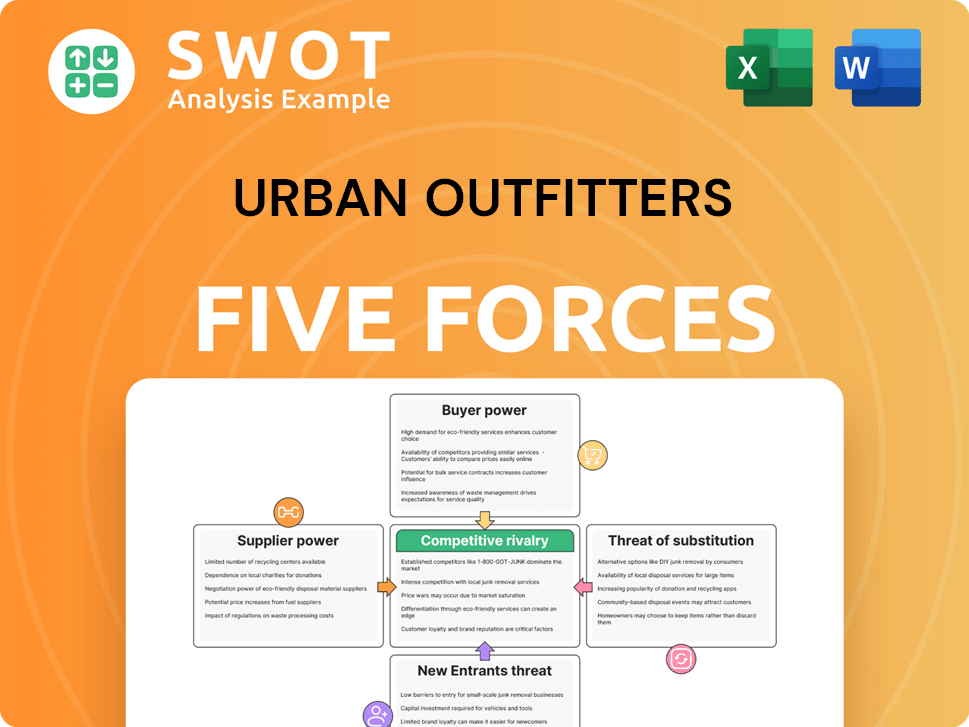
Related Blogs
- What is Competitive Landscape of Urban Outfitters Company?
- What is Growth Strategy and Future Prospects of Urban Outfitters Company?
- How Does Urban Outfitters Company Work?
- What is Sales and Marketing Strategy of Urban Outfitters Company?
- What is Brief History of Urban Outfitters Company?
- Who Owns Urban Outfitters Company?
- What is Customer Demographics and Target Market of Urban Outfitters Company?
Disclaimer
All information, articles, and product details provided on this website are for general informational and educational purposes only. We do not claim any ownership over, nor do we intend to infringe upon, any trademarks, copyrights, logos, brand names, or other intellectual property mentioned or depicted on this site. Such intellectual property remains the property of its respective owners, and any references here are made solely for identification or informational purposes, without implying any affiliation, endorsement, or partnership.
We make no representations or warranties, express or implied, regarding the accuracy, completeness, or suitability of any content or products presented. Nothing on this website should be construed as legal, tax, investment, financial, medical, or other professional advice. In addition, no part of this site—including articles or product references—constitutes a solicitation, recommendation, endorsement, advertisement, or offer to buy or sell any securities, franchises, or other financial instruments, particularly in jurisdictions where such activity would be unlawful.
All content is of a general nature and may not address the specific circumstances of any individual or entity. It is not a substitute for professional advice or services. Any actions you take based on the information provided here are strictly at your own risk. You accept full responsibility for any decisions or outcomes arising from your use of this website and agree to release us from any liability in connection with your use of, or reliance upon, the content or products found herein.